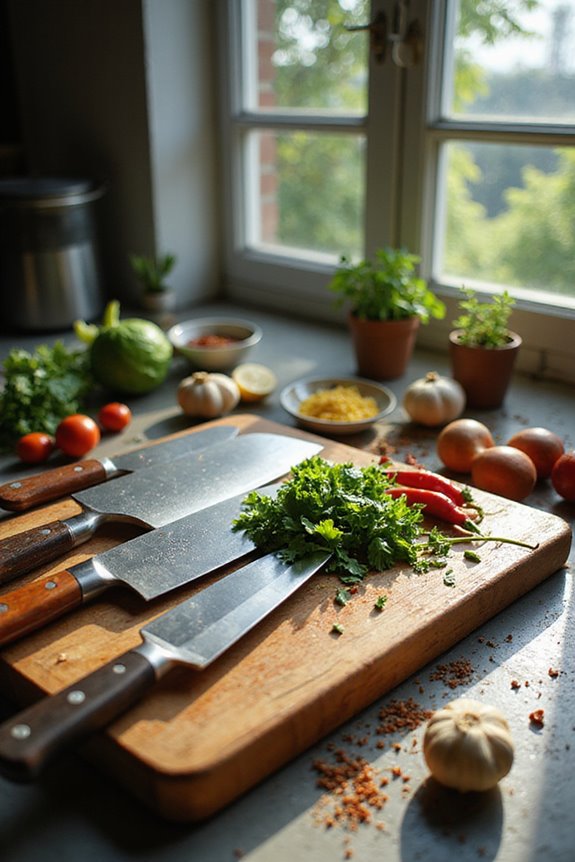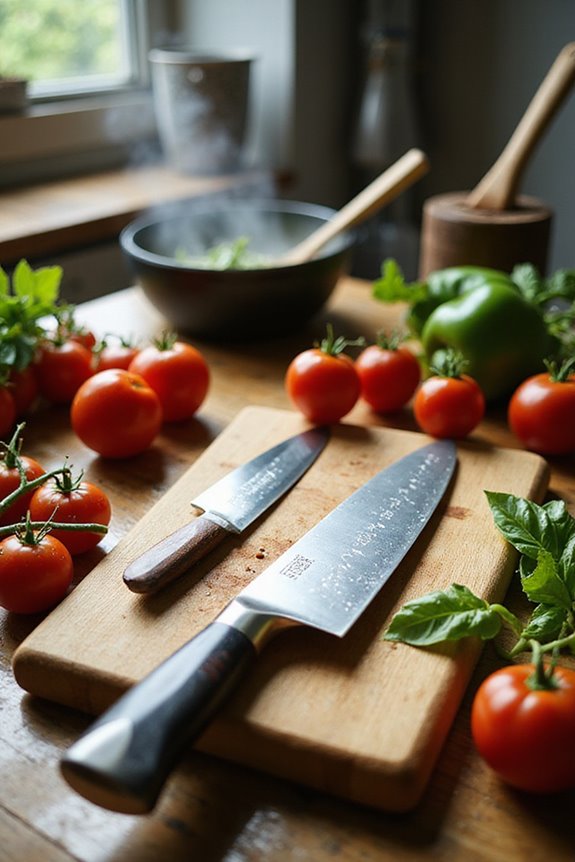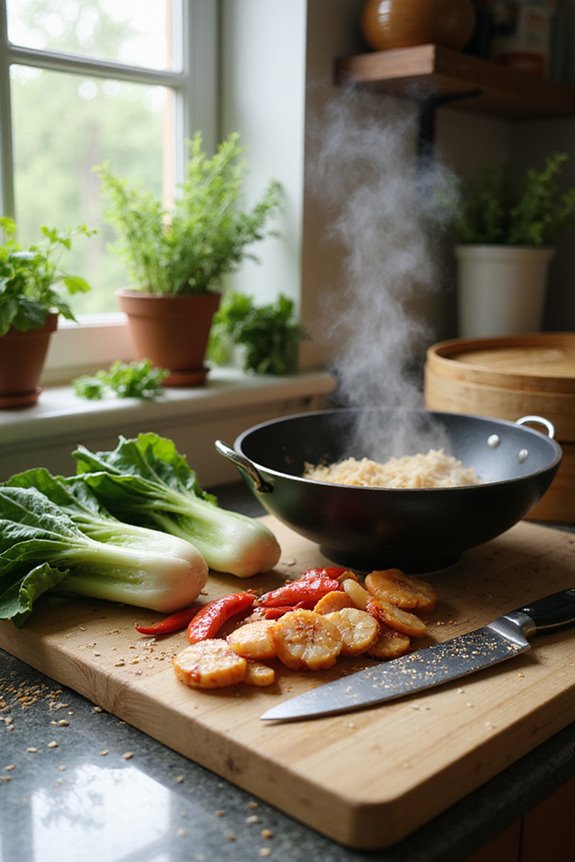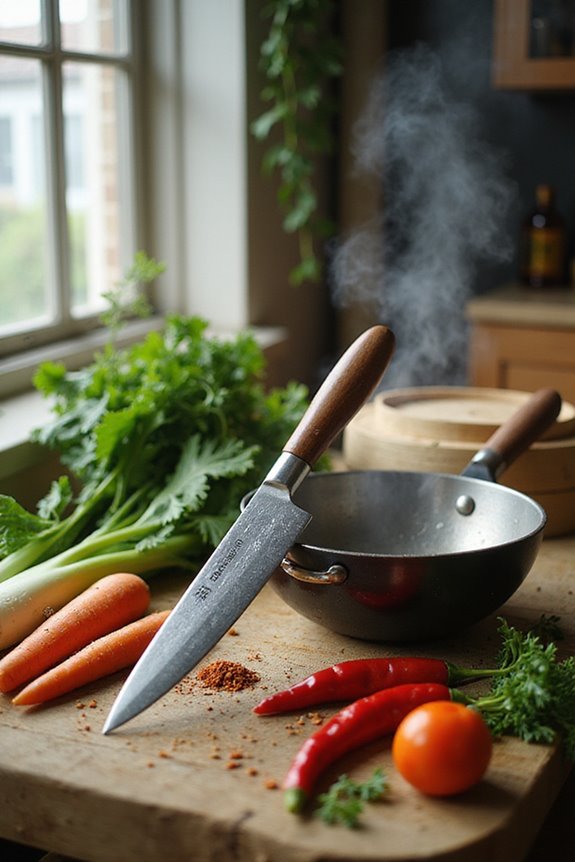As an Amazon Associate, we earn from qualifying purchases. Some links may be affiliate links at no extra cost to you. Although our opinions are based on curated research, we haven't used these products. Articles generated with AI.
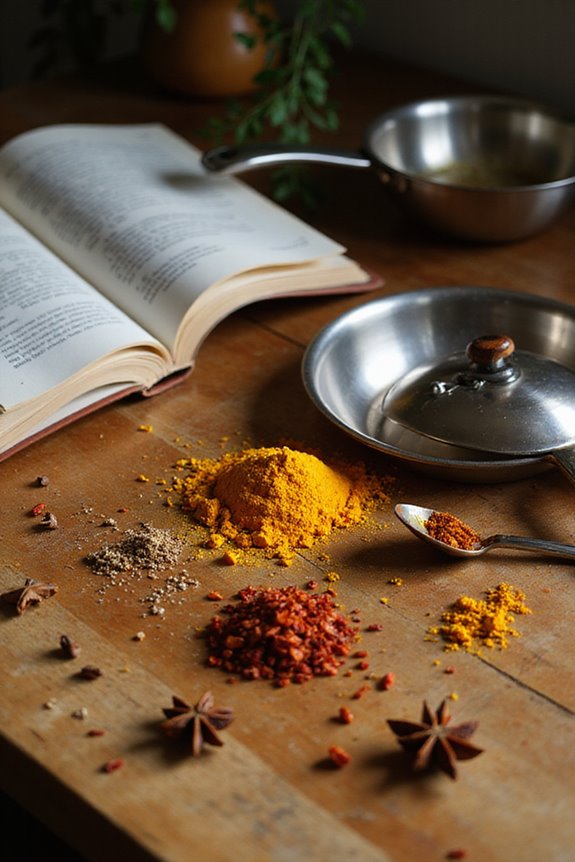
5 Best Malaysian Cookbook Fusion Recipes That Will Elevate Your Culinary Skills
If you want to elevate your culinary skills, check out fusion recipes from top Malaysian cookbooks like “Burma Superstar Cookbook” and “Singapore Cooking.” Combining traditional flavors with innovative techniques, these recipes will enhance your palate. For instance, “My Asian Kitchen” offers a unique take on noodles, while “Falastin” showcases flavorful spices and fresh ingredients. Don’t miss “Singaporean, Malaysian & Indonesian Cuisine” for a broader Asian culinary experience. Keep exploring, and you’ll discover even more fantastic dishes and insights.
Key Takeaways
- Explore fusion recipes that blend traditional Malaysian ingredients like lemongrass and tamarind with local staples for unique flavor combinations.
- Utilize diverse cooking techniques, such as slow cooking and stir-frying, to enhance the complexity and authenticity of fusion dishes.
- Incorporate cultural significance into meals by understanding the traditions behind Malaysian recipes and their communal dining practices.
- Balance sweet, sour, spicy, and savory elements in your fusion dishes using authentic Malaysian spices like sambal and shrimp paste for depth.
- Invest in high-quality cookbooks that feature inspiring images and detailed recipes to elevate both your cooking skills and presentation.
Burma Superstar Cookbook
Sale
Burma Superstar: Addictive Recipes from the Crossroads of Southeast Asia [A Cookbook]
- Hardcover Book
- Tan, Desmond (Author)
- English (Publication Language)
If you’re someone who loves exploring vibrant and unique flavors, the “Burma Superstar Cookbook” is an excellent choice. This book invites you into a culinary adventure, capturing the essence of the beloved restaurant you may miss. You’ll find easy-to-follow recipes, including delightful chayote squash and beef & potato curry that transport your taste buds. The gorgeous binding and high-quality paper enhance the experience, showcasing beautiful photos alongside heartfelt writing. With informative ingredients glossary and insights into the dishes’ origins, it’s not just a cookbook; it’s a gateway to the rich culinary heritage of Southeast Asia, making it a fantastic addition to your collection.
Best For: Food enthusiasts and home cooks seeking to explore authentic Southeast Asian flavors and recreate beloved dishes from Burma Superstar.
Pros:
- Beautifully presented with high-quality photographs and binding, enhancing the overall cooking experience.
- Easy-to-follow recipes that require readily available ingredients, making them accessible for home cooks.
- Offers culinary insights and origins of dishes, enriching the cooking journey and understanding of the cuisine.
Cons:
- Packaging issues when ordering through Amazon may result in damaged copies, which can be frustrating for gift-giving.
- Some recipes may be too simplistic for seasoned chefs looking for more complex cooking challenges.
- Limited availability in physical stores may make it difficult for some to access the book without ordering online.
Singapore Cooking: Fabulous Recipes from Asias Food Capital
Sale
Singapore Cooking: Fabulous Recipes from Asia's Food Capital
- Tan, Terry (Author)
- English (Publication Language)
- 128 Pages - 03/01/2022 (Publication Date) - Tuttle Publishing (Publisher)
“Singapore Cooking: Fabulous Recipes from Asia’s Food Capital” is an ideal choice for home cooks looking to explore the rich tapestry of Singaporean cuisine. This cookbook not only showcases stunning photos but also offers easy-to-follow recipes that bring Singapore’s flavors to your kitchen. Organized into clear sections like Snacks, Soups, and Desserts, each dish is meant to guide you through complex recipes that celebrate a blend of spices and ingredients. While some unique ingredients might pose a challenge, the reward of crafting dishes like Curry Puffs and Bergedel Potato Fish Cakes makes the effort worthwhile. Immerse yourself and enjoy!
Best For: Home cooks and food enthusiasts who are eager to explore and recreate authentic Singaporean dishes.
Pros:
- Full-page photos highlight the beauty of each dish, providing visual inspiration.
- Clear organization into distinct sections makes it easy to navigate and find recipes.
- Diverse flavors offer an opportunity to experiment with authentic ingredients and cooking techniques.
Cons:
- Some specialty ingredients may be difficult to find in all locations, potentially limiting accessibility.
- The complexity of recipes may be daunting for those seeking quick and simple meals.
- Certain dishes may not perfectly replicate the taste of street vendors, leaving some readers wanting more.
My Asian Kitchen: Noodles, Dumplings, Salad, Sushi, Wok, Bao
Sale
My Asian Kitchen: Noodles, Dumplings, Salad, Sushi, Wok, Bao
- Joyce, Jennifer (Author)
- English (Publication Language)
- 256 Pages - 11/07/2023 (Publication Date) - Chartwell Books (Publisher)
For those enthusiastic to indulge in the vibrant world of Asian cuisine, “My Asian Kitchen: Noodles, Dumplings, Salad, Sushi, Wok, Bao” offers an ideal choice. Jennifer Joyce’s beautifully designed cookbook provides straightforward recipes that welcome cooks of all levels. You’ll find familiar ingredients and helpful visuals, making it simple to create delicious dishes. The book expertly blends traditional flavors with modern twists, showcasing fusion recipes like chicken adobo while respecting their roots. With clear cooking techniques and tips, including wrapper mechanics for dumplings, this collection serves as a practical gateway to exploring your culinary creativity in Asian cooking.
Best For: Home cooks eager to explore and enjoy a variety of Asian cuisines, regardless of their cooking experience.
Pros:
- Clear and accessible recipes suitable for cooks of all skill levels.
- Abundant visual aids enhance understanding and inspiration for dish preparation.
- A fusion of traditional and modern recipes celebrates cultural diversity in cooking.
Cons:
- Some traditional recipes may be altered, which could disappoint purists.
- Focusing on common ingredients might limit the exploration of more unique Asian flavors.
- Instructions for certain techniques, while helpful, may still pose challenges for novice cooks.
Falastin: A Cookbook
Exploring the rich tapestry of Palestinian cuisine is an enriching experience that “Falastin: A Cookbook” offers, making it perfect for home cooks enthusiastic to plunge into Middle Eastern flavors. Authored by Sami Tamimi and Tara Wigley, the book beautifully blends recipes with cultural narratives. You’ll discover dishes like buttermilk fattoush and Knafeh Nabulseyeh, each layered with unique flavors. Although you may need specialty ingredients like sumac or za’atar, the book provides alternatives and helpful tips. Beyond just cooking, it fosters a deeper connection to Palestinian heritage, making every meal a celebratory experience rooted in tradition.
Best For: Home cooks and culinary enthusiasts interested in exploring and celebrating authentic Palestinian cuisine and culture.
Pros:
- Offers a diverse array of traditional Palestinian recipes that combine unique flavors and textures.
- Provides insights into Palestinian culture and heritage, enhancing the cooking experience beyond just preparing food.
- Includes helpful tips for ingredient substitutions and accessibility, making it easier for cooks of all levels to engage with the recipes.
Cons:
- Some recipes may require specialty ingredients that may not be readily available in regular grocery stores.
- Multi-part recipes could be time-consuming and may deter inexperienced cooks.
- Certain cooking techniques may be unfamiliar to those new to Middle Eastern cuisine, requiring additional research or practice.
Singaporean, Malaysian & Indonesian Cuisine
Singaporean, Malaysian & Indonesian Cuisine
- Hwang, Christina Sjahir (Author)
- Chinese (Publication Language)
- 96 Pages - 12/18/2025 (Publication Date) - Wei Chuans Cooking (Publisher)
If you’re looking to diversify your culinary skills, the “Malaysian Cookbook Fusion Recipes” is an excellent choice. This cookbook showcases authentic dishes from Singaporean, Malaysian, and Indonesian cuisines, blending flavors and techniques seamlessly. Each recipe comes with bilingual instructions, making it accessible for everyone. You’ll find beautiful photographs that guide you so you know what your final dish should look like. Users appreciate easy ingredient sourcing and often enjoy improvising, leading to delicious results. However, pay attention to measurements, as some recipes might use ounces instead of cups, which could require recalibrating your ingredients for perfect outcomes.
Best For: Home cooks looking to explore the vibrant flavors of Southeast Asian cuisine through easy-to-follow recipes.
Pros:
- Beautiful photographs guide users in recreating authentic dishes.
- Bilingual instructions make the cookbook accessible to a wider audience.
- Easy ingredient sourcing allows for improvisation and flexibility in cooking.
Cons:
- Some recipes use ounces instead of cups, causing measurement discrepancies.
- It’s noted as the least favorite among Wei-Chuan publications compared to others.
- Certain users may need to adjust spice levels to suit personal taste preferences.
Factors to Consider When Choosing Malaysian Cookbook Fusion Recipes
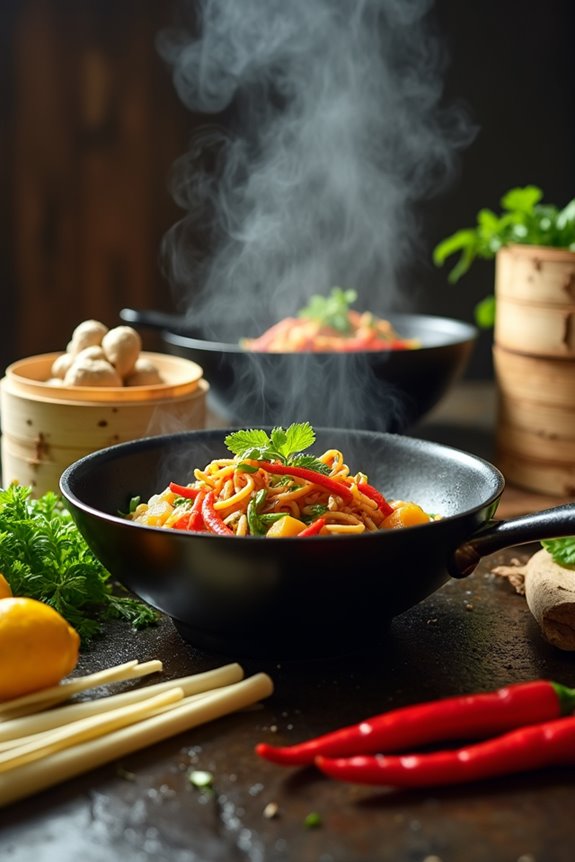
When choosing Malaysian cookbook fusion recipes, you’ll want to contemplate several key factors. Recipe authenticity and ingredient availability are critical, as they affect how easily you can recreate these dishes. Additionally, think about preparation time, cultural significance, and the flavor profiles you enjoy; these elements will ultimately shape your cooking experience and satisfaction.
Recipe Authenticity Consideration
To guarantee you’re selecting authentic Malaysian cookbook fusion recipes, it’s essential to take into account several key factors that honor the rich culinary heritage of the region. First, look for recipes that employ traditional ingredients and techniques, such as galangal, lemongrass, and tamarind, which are crucial for authentic flavors. Next, consider the adherence to cultural practices, reflecting methods passed down through generations. Additionally, cookbooks that include historical context can deepen your appreciation for the dishes. Finally, evaluate the balance of flavors—authentic fusion should maintain significant Malaysian elements while respectfully incorporating global influences. By focusing on these aspects, you’ll enhance not just your cooking skills but also your understanding of Malaysian culinary traditions.
Ingredient Availability Impact
Choosing Malaysian cookbook fusion recipes requires careful consideration of ingredient availability, as many authentic dishes rely on specific components to achieve their signature flavors. You might find that ingredients such as pandanus leaves or fresh galangal aren’t always available in your local stores. This can lead to challenges in replicating authentic tastes, making some recipes more difficult or time-consuming to prepare. While many fusion recipes allow for improvisation, switching out ingredients can alter the dish’s authenticity and final flavor profile. Understanding the availability of unique spices and local markets can enhance your cooking experience. It ultimately helps in selecting recipes that align well with accessible ingredients, ensuring your culinary creations remain enjoyable and satisfying.
Preparation Time Required
Understanding the preparation time required for Malaysian fusion recipes is essential for planning your cooking sessions effectively. Preparation times can vary greatly, with recipes ranging from quick 30-minute meals to complex dishes that need hours of marinating or cooking. Many recipes have multiple components, including marinades and sauces, which add to the overall prep time. Traditional Malaysian techniques, like slow cooking or intricate chopping, can also extend this time. Additionally, sourcing specialty ingredients may require extra planning and trips to specific markets. While some fusion recipes prioritize efficiency and simplicity, others embrace the rich, layered flavors of Malaysian cuisine, often leading to longer preparation times for those authentic taste results you’re after.
Cultural Significance Emphasis
Cultural significance plays a key role when you explore Malaysian cookbook fusion recipes. Understanding Malaysian cuisine’s rich tapestry of influences—from Malay to Chinese, Indian, and indigenous traditions—helps you appreciate fusion dishes deeply. These culinary practices emerged from centuries of trade and migration, so recognizing their origins enriches your cooking experience. Many recipes emphasize communal dining, reflecting the importance of sharing meals within families and friend groups. By incorporating traditional ingredients and techniques, you pay homage to Malaysia’s heritage while adding your twist. Additionally, understanding the symbolism of certain dishes, often tied to celebrations and life events, will elevate your appreciation of these fusion recipes, giving you a deeper connection to the meals you prepare and enjoy.
Flavor Profiles and Combinations
While creating fusion recipes inspired by Malaysian cuisine, it’s vital to appreciate the intricate flavor profiles that define it. Malay dishes skillfully blend sweet, sour, spicy, and savory elements, so aim for balance in your creations. Use tamarind or lime to bring acidity, and consider adding coconut milk for richness. Don’t forget about heat—sambal or chili can elevate your recipe. Incorporate herbs and spices like lemongrass, galangal, and pandan to add aromatic depth. You can pair traditional Malaysian ingredients with local staples; imagine Malaysian spices mixed into Italian pasta or Indian curries. Finally, understanding umami—often derived from shrimp paste or soy sauce—will guarantee your fusion dishes are well-rounded and appealing to a wide audience.
Skill Level Assessment
When diving into Malaysian fusion recipes, it’s essential to contemplate your cooking skill level. Assess your experience with Malaysian cuisine, as some dishes may demand advanced techniques or unique ingredients. Start with simple recipes that blend familiar flavors, gradually moving to complex dishes with multiple components. Clear recipe instructions are crucial; choose those that match your skill level to boost confidence and enjoyment while cooking. Also, consider the availability of ingredients—if some items are hard to source, opt for recipes that use readily accessible components. Finally, review feedback from other cooks to gauge the difficulty of specific recipes, ensuring you select those that align with your current abilities for successful results.
Cooking Equipment Needs
Choosing the right cooking equipment is vital for successfully preparing Malaysian fusion recipes. Start with versatile tools like woks, steamers, and clay pots, which are important for traditional techniques. Don’t forget specialized utensils like a mortar and pestle for spice grinding or bamboo steamers for dumplings. Assess your kitchen appliances; make sure your blender or food processor can handle the rich sauces and pastes typical of Malaysian cuisine. Reliable cookware is key for frying and stir-frying, so choose items that withstand high heat and promote even cooking. Finally, consider how you’ll store unique ingredients like various spices and fresh herbs, as proper containers or refrigeration are necessary to keep them fresh and accessible for your culinary creations.
Visual Appeal Importance
Visual appeal plays an essential role in the enjoyment of Malaysian cookbook fusion recipes, as it brings the vibrant flavors and textures of this cuisine to life. When selecting a cookbook, consider those with beautiful photographs that inspire creativity and encourage you to experiment with flavors. High-quality images illustrate essential plating techniques and presentation styles, crucial to Malaysian cooking traditions. Cookbooks featuring step-by-step images can clarify complex processes, boosting your confidence as a home cook. Striking visuals not only enhance your dish’s aesthetic but also foster a deeper appreciation for the culture behind it. Ultimately, a visually engaging cookbook can turn cooking into an exciting journey while making your culinary creations more inviting and enjoyable.
Frequently Asked Questions
What Essential Ingredients Are Common in Malaysian Fusion Recipes?
Imagine if soy sauce and chili paste had a culinary baby—welcome to Malaysian fusion! Common ingredients in these recipes include coconut milk, tamarind, and lemongrass, which bring depth to dishes. You’ll often find rice noodles, shrimp, and various spices like turmeric and cardamom highlighting flavor profiles. Don’t forget about fresh herbs like cilantro and Thai basil; they’re key to balancing the richness with brightness in your meal. Immerse yourself and explore!
Can I Substitute Ingredients in Malaysian Fusion Recipes?
You can absolutely substitute ingredients in Malaysian fusion recipes. For example, if a recipe calls for lemongrass and you can’t find it, try using lemon zest instead. Coconut milk can be swapped with dairy-free alternatives for a different flavor profile while keeping the dish vegan. Just be mindful of balancing flavors, as some substitutes might alter the overall taste. Always consider the texture and heat level to guarantee your dish remains delightful.
How Do I Adapt Traditional Recipes for Dietary Restrictions?
Did you know that nearly 50% of people have dietary restrictions? To adapt traditional recipes, start by identifying the key flavors and ingredients. For instance, if a recipe calls for dairy, you can use plant-based alternatives like almond or oat milk. When it comes to gluten, opt for rice flour or alternative grains. Always keep the balance of flavors in mind, ensuring your dish remains delicious while catering to dietary needs.
What Kitchen Tools Are Essential for Malaysian Cooking?
To cook Malaysian dishes effectively, you’ll need some key kitchen tools. A good wok is essential for stir-frying, while a mortar and pestle helps you prepare aromatic pastes. Invest in sharp knives for precise chopping, along with a rice cooker for perfectly steamed rice. Don’t forget a heavy-bottomed pot for curries! Finally, measuring spoons and cups guarantee your recipes stay accurate, delivering those rich, bold flavors typical of Malaysian cuisine with ease.
How Can I Improve My Skills With Malaysian Fusion Recipes?
To improve your skills with Malaysian fusion recipes, start by experimenting with classic ingredients like lemongrass, turmeric, and coconut milk. You can also watch online tutorials to grasp techniques. Don’t shy away from combining elements from other cuisines, such as Indian spices or Chinese methods, to add unique flavors. Practice making staple dishes, adjusting recipes based on your taste preferences. Finally, document your results to track your progress and discover what works best.

![Burma Superstar: Addictive Recipes from the Crossroads of Southeast Asia [A Cookbook]](https://m.media-amazon.com/images/I/51AlTDQo89L.jpg)




